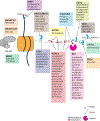Pharmacological targeting of the cancer epigenome
- PMID: 38937652
- PMCID: PMC11936478
- DOI: 10.1038/s43018-024-00777-2
Pharmacological targeting of the cancer epigenome
Abstract
Epigenetic dysregulation is increasingly appreciated as a hallmark of cancer, including disease initiation, maintenance and therapy resistance. As a result, there have been advances in the development and evaluation of epigenetic therapies for cancer, revealing substantial promise but also challenges. Three epigenetic inhibitor classes are approved in the USA, and many more are currently undergoing clinical investigation. In this Review, we discuss recent developments for each epigenetic drug class and their implications for therapy, as well as highlight new insights into the role of epigenetics in cancer.
© 2024. Springer Nature America, Inc.
Figures




References
-
- Hanahan D Hallmarks of Cancer: New Dimensions. Cancer Discov 12, 31–46 (2022). 10.1158/2159-8290.CD-21-1059 - DOI - PubMed
Publication types
MeSH terms
Substances
Grants and funding
LinkOut - more resources
Full Text Sources
Medical
Research Materials

